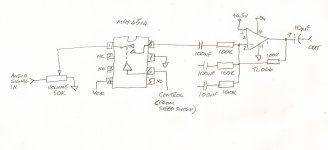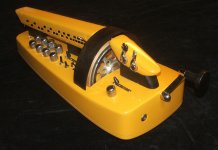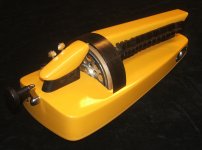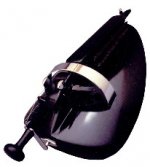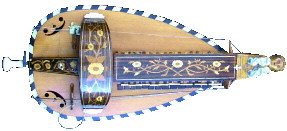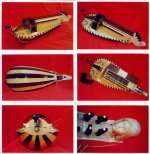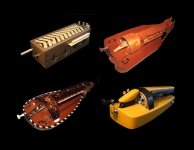Hello Everybody,
I'm new to the forum. The reason I've joined up is because I've been trying to build electronic projects but I'm not an EE, I'm an ME. I get along OK in general but I'm having some problems at the moment with an analog switch. I use it to trigger different audio signals on a musical instrument I've built and it often makes ‘clicks’ or ‘pops’ when it turns on. I believe that if the input and output lines of an analog switch are at the same voltage level at the time of switching the ‘click’ will not be present, but how do I achieve this? Tie-up or tie-down resistors on both sides? I’m really not sure. Maxim apparently make ‘clickless’ analog switches but these are only sold in sub-miniature packages for portable phones and other similar devices and are not suitable for my home workshop; I need something in a DIP configuration. The analog switches I’m using are MAX4514 SPST switches that come in a DIP-8 package.
There’s a schematic attached showing a typical installation of the analog switch plus a couple of photos of the assembled instrument. Again, thanks for any help you can give me with this project.
Vielle568
I'm new to the forum. The reason I've joined up is because I've been trying to build electronic projects but I'm not an EE, I'm an ME. I get along OK in general but I'm having some problems at the moment with an analog switch. I use it to trigger different audio signals on a musical instrument I've built and it often makes ‘clicks’ or ‘pops’ when it turns on. I believe that if the input and output lines of an analog switch are at the same voltage level at the time of switching the ‘click’ will not be present, but how do I achieve this? Tie-up or tie-down resistors on both sides? I’m really not sure. Maxim apparently make ‘clickless’ analog switches but these are only sold in sub-miniature packages for portable phones and other similar devices and are not suitable for my home workshop; I need something in a DIP configuration. The analog switches I’m using are MAX4514 SPST switches that come in a DIP-8 package.
There’s a schematic attached showing a typical installation of the analog switch plus a couple of photos of the assembled instrument. Again, thanks for any help you can give me with this project.
Vielle568
Attachments
You may find that the MAX4744 series or other clickless analog switches are the most satisfactory way to go, despite the difficulties involved in using them. These are smart devices, and trying to bolt-on the functionality they offer may be difficult.
You have obviously put a lot of effort into your instrument already, perhaps you could get someone to assemble a custom board for you, just for this function.
Making a homemade board work with these surface mount components is not impossible. You need a good layout software, access to a laser printer, transparency material, resist-coated PCB, a UV lightbox, develop and etch chemicals, some solder paste and a toaster oven.
Or you can get boards made from your layout for reasonable prices. These are easier to oven solder because of the tinning and solder resist. Then you just need the solder paste and toaster oven. Some people like to stencil the solder paste on. You can get a cheap laser-cut plastic stencil. If you're lucky you can use one of the patterns on the company's sampler, I must have done a dozen boards with mine.
Note that the MAX4744 requires attention to power supply sequencing.
w
You could maybe have a daughterboard arrangement to fit into DIP sockets.
You have obviously put a lot of effort into your instrument already, perhaps you could get someone to assemble a custom board for you, just for this function.
Making a homemade board work with these surface mount components is not impossible. You need a good layout software, access to a laser printer, transparency material, resist-coated PCB, a UV lightbox, develop and etch chemicals, some solder paste and a toaster oven.
Or you can get boards made from your layout for reasonable prices. These are easier to oven solder because of the tinning and solder resist. Then you just need the solder paste and toaster oven. Some people like to stencil the solder paste on. You can get a cheap laser-cut plastic stencil. If you're lucky you can use one of the patterns on the company's sampler, I must have done a dozen boards with mine.
Note that the MAX4744 requires attention to power supply sequencing.
w
You could maybe have a daughterboard arrangement to fit into DIP sockets.
Last edited:
The ideal would be a zero-crossing switch. i.e. One that delays switch-on (and switch-off too?) until the input signal passes through zero.
Hi Guys,
Thanks for the info on the analog switches. I checked ou the MAX4744 and it looks fine but as you pointed out it's in a tiny package just 2mm square. OK, I've a small tip on my soldering iron and some powerful glasses but I'll never manage to get that chip wired up without professional help. I did however stumble on a chip made by Analog Devices, the SSM2404P. This is a 20pin DIP package chip that houses 4 SPST 'clickless' analog switches specially designed for audio applications. I use three in my design and so I could easily replace the them with this one IC. I don't know if anyone has used this product but it has a 'make-before-break' circuit plus a surge switch to control the clicks and pops when switching different level signals. It runs off of a single or double supply if required.
Yes, it's an electric hurdy-gurdy (vielle in French). The melody comes from a humbucker pick-up tapping the string that runs through the keyboard but the rest of the instrument is electronic. The rhythm is generated by a laser that monitors the wheel speed. A pulse signal is sent to a voltage to frequency converter that controls an analog switch; this switch pulses the audio signal for the rhythm. The drone signals are generated from synthesizer modules. The instrument plays OK but could do with a just little refining here and there to bring it to prefection.
Cheers!
vielle568
Thanks for the info on the analog switches. I checked ou the MAX4744 and it looks fine but as you pointed out it's in a tiny package just 2mm square. OK, I've a small tip on my soldering iron and some powerful glasses but I'll never manage to get that chip wired up without professional help. I did however stumble on a chip made by Analog Devices, the SSM2404P. This is a 20pin DIP package chip that houses 4 SPST 'clickless' analog switches specially designed for audio applications. I use three in my design and so I could easily replace the them with this one IC. I don't know if anyone has used this product but it has a 'make-before-break' circuit plus a surge switch to control the clicks and pops when switching different level signals. It runs off of a single or double supply if required.
Yes, it's an electric hurdy-gurdy (vielle in French). The melody comes from a humbucker pick-up tapping the string that runs through the keyboard but the rest of the instrument is electronic. The rhythm is generated by a laser that monitors the wheel speed. A pulse signal is sent to a voltage to frequency converter that controls an analog switch; this switch pulses the audio signal for the rhythm. The drone signals are generated from synthesizer modules. The instrument plays OK but could do with a just little refining here and there to bring it to prefection.
Cheers!
vielle568
Hi vielle568
I had a mate a few years ago who played hurdy gurdy and crumhorn, though not at the same time. He got work with re enactment societies playing period instruments quite a bit. He had a bombarde too but said that was very hard to play.
A lovely piece of work, I hope you get it working to your satisfaction.
John
I had a mate a few years ago who played hurdy gurdy and crumhorn, though not at the same time. He got work with re enactment societies playing period instruments quite a bit. He had a bombarde too but said that was very hard to play.
A lovely piece of work, I hope you get it working to your satisfaction.
John
Hi John,
Thanks for your encouragement. I've got most of the teething problems out of it; there's just a few irritating things that I want to weed out that are taking some time. In fact I played it last night at a gig and it worked fine (although I didn't use all the functions).
You're right, it's difficult to play hurdy-gurdy and curmhorn at the same time. I too have played for many years in a medieval ensemble and made the instruments too. As for the bombarde, well, the reeds require quite a bit of pressure and usually the instrument only plays the first part of the phrase and not the repeat. This way the player doesn't get worn out by having to play all the time.
Here's a couple more instruments from my shop if you're interested: a bombarde and a couple of vielles...
vielle568
Thanks for your encouragement. I've got most of the teething problems out of it; there's just a few irritating things that I want to weed out that are taking some time. In fact I played it last night at a gig and it worked fine (although I didn't use all the functions).
You're right, it's difficult to play hurdy-gurdy and curmhorn at the same time. I too have played for many years in a medieval ensemble and made the instruments too. As for the bombarde, well, the reeds require quite a bit of pressure and usually the instrument only plays the first part of the phrase and not the repeat. This way the player doesn't get worn out by having to play all the time.
Here's a couple more instruments from my shop if you're interested: a bombarde and a couple of vielles...
vielle568
Attachments
Hi vielle.
It just gets better and better!
The marquetry alone must have taken forever. Is there much demand for instruments of that kind in France?
Everyone in England is playing Guitar Hero. I don't think Hurdy Gurdy Hero would catch on but I would like to see it.
John
It just gets better and better!
The marquetry alone must have taken forever. Is there much demand for instruments of that kind in France?
Everyone in England is playing Guitar Hero. I don't think Hurdy Gurdy Hero would catch on but I would like to see it.
John
Hi John,
Thanks for your compliments. The black vielle is an electro-acoustic model and this type is getting fairly popular. The electric version I have just built is a one-of-a-kind prototype and I don't know of another quite like it. It can generate all the same sounds and effects you get to hear from an electric guitar but of course the playing technique is totally different. The guitar will always remain the more popular instrument but I've always been fascinated by the vielle (hurdy-gurdy) and have been trying to develop it for quite a while.
Incidently, I used to live in Liverpool and work at the Ford plant at Halewood when I was a young engineer; but that's going back a few years!
vielle568
Thanks for your compliments. The black vielle is an electro-acoustic model and this type is getting fairly popular. The electric version I have just built is a one-of-a-kind prototype and I don't know of another quite like it. It can generate all the same sounds and effects you get to hear from an electric guitar but of course the playing technique is totally different. The guitar will always remain the more popular instrument but I've always been fascinated by the vielle (hurdy-gurdy) and have been trying to develop it for quite a while.
Incidently, I used to live in Liverpool and work at the Ford plant at Halewood when I was a young engineer; but that's going back a few years!
vielle568
Hi Vielle.
Liverpool must have been quite a shock coming from your rural location. The Deux Sèvres region looks lovely by the photos on google.
It was Capital of Culture recently, it made no difference at all to the lives of the average person though. A huge amount of money was spent on fancy lamp posts for a few streets and a big new shopping centre was built. It has all the same shops you would see in any other city and all the small independent shops have closed as the city centre was blocked for so long.
Ford is now Jaguar but I hear it isn't doing too well, no car factories are in a good shape currently.
John
Liverpool must have been quite a shock coming from your rural location. The Deux Sèvres region looks lovely by the photos on google.
It was Capital of Culture recently, it made no difference at all to the lives of the average person though. A huge amount of money was spent on fancy lamp posts for a few streets and a big new shopping centre was built. It has all the same shops you would see in any other city and all the small independent shops have closed as the city centre was blocked for so long.
Ford is now Jaguar but I hear it isn't doing too well, no car factories are in a good shape currently.
John
Hi John,
Ok, so Ford is now Jaguar is it? I'd heard that Liverpool had been referred to as a city of culture, but somehow it didn't quite fit the image in my mind! I was there at the end of the sixties; just after the Beatles left, squashed in between Anfield and Goodison Park and long before the city had any sort of restoration. I eventually got my qualifications and then left the country and worked in LA building satellite test equipment for many years. Yes, Deux Sèvres is nice and calm after life in the city!
When I saw that you were in the Wirral it brought back memories of Liverpool. I had friends living at Heswall and Irby; most of the Wirral was very beautiful from what I can recall (although Birkenhead was a rather industrial area). I don't know where you are but I imagine that it's quite attractive in your region too.
I think we're straying off the subject of audio technology but what the hell!
Cheers!
vielle568
Ok, so Ford is now Jaguar is it? I'd heard that Liverpool had been referred to as a city of culture, but somehow it didn't quite fit the image in my mind! I was there at the end of the sixties; just after the Beatles left, squashed in between Anfield and Goodison Park and long before the city had any sort of restoration. I eventually got my qualifications and then left the country and worked in LA building satellite test equipment for many years. Yes, Deux Sèvres is nice and calm after life in the city!
When I saw that you were in the Wirral it brought back memories of Liverpool. I had friends living at Heswall and Irby; most of the Wirral was very beautiful from what I can recall (although Birkenhead was a rather industrial area). I don't know where you are but I imagine that it's quite attractive in your region too.
I think we're straying off the subject of audio technology but what the hell!
Cheers!
vielle568
Hi Vielle.
Parts of the wirral are still nice, it is much loved by footballers in the nice parts. Birkenhead is now devoid of any industry, the shipyards have gone and so have all the supporting industries. It is a region of sunbed parlours and fast food outlets now.
I have only been around here for a few years, I am not far from Birkenhead so attractive isn't a word I would use to describe it. Cheap is though, a 4 bedroomed house for £38,000 was one of the attractions. I have a room with nothing but 2 chairs and home made hifi in it.
I had been working abroad too, though I was in Holland and Belgium, When we returned to Britain the choice was to live somewhere expensive and be a wage slave or to live somewhere cheap for a while and see what happened.
My girlfriend is fascinated by the hurdy gurdys (ooh, the topic!) How much would you expect to pay for a beginners instrument as she is quite taken with them. I understand that your builds are well out of my price range but Christmas will be upon us soon and it would be an unusual gift. I was involved in motor manufacture so my bank balance has taken quite a hit, should I ever get it back on track though I will be in touch!
John
Parts of the wirral are still nice, it is much loved by footballers in the nice parts. Birkenhead is now devoid of any industry, the shipyards have gone and so have all the supporting industries. It is a region of sunbed parlours and fast food outlets now.
I have only been around here for a few years, I am not far from Birkenhead so attractive isn't a word I would use to describe it. Cheap is though, a 4 bedroomed house for £38,000 was one of the attractions. I have a room with nothing but 2 chairs and home made hifi in it.
I had been working abroad too, though I was in Holland and Belgium, When we returned to Britain the choice was to live somewhere expensive and be a wage slave or to live somewhere cheap for a while and see what happened.
My girlfriend is fascinated by the hurdy gurdys (ooh, the topic!) How much would you expect to pay for a beginners instrument as she is quite taken with them. I understand that your builds are well out of my price range but Christmas will be upon us soon and it would be an unusual gift. I was involved in motor manufacture so my bank balance has taken quite a hit, should I ever get it back on track though I will be in touch!
John
I think we're straying off the subject of audio technology
Not to worry my friend, you're posting in the Intro section anyway. 🙂
Hi john,
Wow, its difficult to imagine Birkenhead devoid of all the dockland and industry! I guess things have really changed since I there all those years ago. The house price you mentioned is certainly cheap. I seem to recall that the southern side of the Wirral was a different class of lifestyle and housing was not at all in that price range. Maybe that's changed too.
I can understand your dilemma about the UK. Every time I return to visit my family (London) the place seems more and more crowded and the housing is getting more expensive. Either you get out in the country at the expense of your job or you battle away in a city for a good salary but with an aggressive lifestyle. After working in London, Liverpool, and LA, the French countryside is a welcome relief.
As for getting a hurdy-gurdy, well it will set you back a bit because they are all hand made and even a basic student model requires the same manhours to produce the complex instrument. If you add the carved head and marquetery that you find on the traditional models then it's going to put the price up even further. Typically a basic model will cost somewhere between £1500 and £2000; this is a very generous gift for your girlfriend. However, if the instrument is kept in good shape it will still keep most of it's value should you need to sell it. Check out 'Chris Allen hurdy-gurdy'. This is a maker I know over in the UK who makes reasonable quality vielles and not that expensive; his site has photos and prices. My site is off-line at the moment so I have nothing to offer; sorry. My prices are similar; as I said, it just takes time to do all the work. There's a few photos of some of my vielles; a mixture of medieval, renaissance, traditional and modern instruments.
Ciao,
vielle568
Wow, its difficult to imagine Birkenhead devoid of all the dockland and industry! I guess things have really changed since I there all those years ago. The house price you mentioned is certainly cheap. I seem to recall that the southern side of the Wirral was a different class of lifestyle and housing was not at all in that price range. Maybe that's changed too.
I can understand your dilemma about the UK. Every time I return to visit my family (London) the place seems more and more crowded and the housing is getting more expensive. Either you get out in the country at the expense of your job or you battle away in a city for a good salary but with an aggressive lifestyle. After working in London, Liverpool, and LA, the French countryside is a welcome relief.
As for getting a hurdy-gurdy, well it will set you back a bit because they are all hand made and even a basic student model requires the same manhours to produce the complex instrument. If you add the carved head and marquetery that you find on the traditional models then it's going to put the price up even further. Typically a basic model will cost somewhere between £1500 and £2000; this is a very generous gift for your girlfriend. However, if the instrument is kept in good shape it will still keep most of it's value should you need to sell it. Check out 'Chris Allen hurdy-gurdy'. This is a maker I know over in the UK who makes reasonable quality vielles and not that expensive; his site has photos and prices. My site is off-line at the moment so I have nothing to offer; sorry. My prices are similar; as I said, it just takes time to do all the work. There's a few photos of some of my vielles; a mixture of medieval, renaissance, traditional and modern instruments.
Ciao,
vielle568
Attachments
Hi Vielle.
The other side of the Wirral is still a lot more expensive than this side. There are some lovely old places over there, and more Aston Martins than you can count. It will be much more built up than when you saw it last. There was a frantic rush to build houses on any patch of green land a few years ago, many are still unoccupied.
The biggest change you would see would be on the River Mersey, it is empty now.
Jills Dad worked in the Liver Buildings in the 60s and speaks of 7 miles of ships in dock on the Liverpool side. The docks are largely derelict now, the Albert Dock was turned into a shopping centre, a common theme. There are plans to convert the docks on the wirral side into something called "Shanghai Towers", it will feature a shopping centre!
They say it is down to the containerisation of freight. One big computer managed crane can move more freight in containers than an army of men could. The remaining dock at Seaforth handles more freight now than ever, but with a fraction of the workforce.
The price for the amount of work in your vielles is well justified, if anything they seem a bargain. One day when I have saved some cash and not spent it on yet another amp.......
John
The other side of the Wirral is still a lot more expensive than this side. There are some lovely old places over there, and more Aston Martins than you can count. It will be much more built up than when you saw it last. There was a frantic rush to build houses on any patch of green land a few years ago, many are still unoccupied.
The biggest change you would see would be on the River Mersey, it is empty now.
Jills Dad worked in the Liver Buildings in the 60s and speaks of 7 miles of ships in dock on the Liverpool side. The docks are largely derelict now, the Albert Dock was turned into a shopping centre, a common theme. There are plans to convert the docks on the wirral side into something called "Shanghai Towers", it will feature a shopping centre!
They say it is down to the containerisation of freight. One big computer managed crane can move more freight in containers than an army of men could. The remaining dock at Seaforth handles more freight now than ever, but with a fraction of the workforce.
The price for the amount of work in your vielles is well justified, if anything they seem a bargain. One day when I have saved some cash and not spent it on yet another amp.......
John
I checked ou the MAX4744 and it looks fine but as you pointed out it's in a tiny package just 2mm square. OK, I've a small tip on my soldering iron and some powerful glasses but I'll never manage to get that chip wired up without professional help.
Granted, this is a very tiny chip, I did not necessarily mean to suggest that you could work with this particular one. I didn't search through all the devices, but I am fairly sure that there are some bigger than these, although still SMT with concealed pads.
SMT soldering often does not involve a soldering iron. A small amount of solder paste is applied to the board, sometimes in a continuous line across a row of pads. The chip is placed on the paste, and steered into the right position if necessary. The board is heated in a 'toaster oven'.
7L Mini Oven Grill and Toaster: Amazon.co.uk: Home & Garden
When the solder melts, surface tension causes the line of solder to break into individual puddles over the pads, and surface tension also pulls the chip into the correct position. It's entertaining to see a board tidy itself up in this way, and with a bit of practise failed joints are rare. It's all about technique, like many aspects of woodwork and marquetry. Surface mount is preferable to through hole in so very many respects. Making a few hundred connections simultaneously is just part of the story. If you make your own boards, not having to drill holes is a real boon.
There are some good sites dealing with these techniques...
The other thing that I was suggesting is that you could get a bit of professional help. You could get somebody to solder a few of these chips to boards and break out the connections to 0.1in square pads that you could solder wires to, or even make a daughterboard with pins to plug onto your existing board. Anyway, I'm sure you'll get there one way or another, considering your other achievements.
w
Nice work.
Hi Wakibaki,
Thanks for your detailled explanation about SMT techniques. You're right, I probably could get the chips in place with a properly printed board and a toaster oven; I'll probably end up using this technique one day as more and more chips are being manufactured in the space saving packages. However, since I don't have any equipment to make PCBs at the present time I have been busy searching for an alternative solution.
I came across the SSM2404P made by Analog Devices; this is a quad SPST analog switch especially designed for audio signals. It has a guaranted break-before-make connection to eliminate the clicks and pops. It will also run off of a single supply and requires little power. I don't know if you are familiar with this chip but I found a vendor that will sell me a small quantity and so I've ordered a few for my project. In fact there are just three SPST switches in my design so a single (quad) chip will be adequate.
By the way, your last line "Mike zerO Romeo Oscar November" doesn't refer to me does it?
vielle568
Thanks for your detailled explanation about SMT techniques. You're right, I probably could get the chips in place with a properly printed board and a toaster oven; I'll probably end up using this technique one day as more and more chips are being manufactured in the space saving packages. However, since I don't have any equipment to make PCBs at the present time I have been busy searching for an alternative solution.
I came across the SSM2404P made by Analog Devices; this is a quad SPST analog switch especially designed for audio signals. It has a guaranted break-before-make connection to eliminate the clicks and pops. It will also run off of a single supply and requires little power. I don't know if you are familiar with this chip but I found a vendor that will sell me a small quantity and so I've ordered a few for my project. In fact there are just three SPST switches in my design so a single (quad) chip will be adequate.
By the way, your last line "Mike zerO Romeo Oscar November" doesn't refer to me does it?
vielle568
Hi John,
It sounds as though some things are still the same; the houses for the wealthy on the southern side of the Wirral. I’d read about the Albert Docks being turned into a shopping centre but I didn’t realise that all Liverpool’s dockland had died. OK, so Seaforth has taken over with the container port at the entry to the Mersey; I suppose it stands to reason; the place was more accessible than Liverpool anyway. I remember the Liver buildings being black! I suppose Jill’s Dad must have cleaned them up when he worked on them all those years ago.
This area where I live is an agricultural region and an inexpensive part of the country. Housing here is cheap (but most houses require restoration) and the main problem of course is that if you’re not a farm worker there’s little chance of employment. I have my own little business so I can keep my head above water; just. Even so I only have a small stone cottage and a workshop; nothing more. I won’t complain though because life here in the country is nice and calm and I have no desire to return to LA or London.
The hurdy-gurdy takes about a month to build, so if you consider the cost of a month’s labour and then deduct the usual taxes and social charges that you find in a pay cheque (plus the cost of the building materials) you’ll arrive at the total cost. As you can see, an instrument for £1500 doesn’t give the maker much of a profit. Please don’t think we are rolling in money because that’s not the case!
If your girlfriend is interested in getting a hurdy-gurdy why don’t you let her do the inquiries and pay for the instrument? After all, if your passion is amplifiers wouldn’t you rather be spending your money on parts for your amp projects?
Anyway, we’ve spoken about some of the things I’ve been building, what about telling me about your creations? Come on John, put the cards on the table!
Vielle568
It sounds as though some things are still the same; the houses for the wealthy on the southern side of the Wirral. I’d read about the Albert Docks being turned into a shopping centre but I didn’t realise that all Liverpool’s dockland had died. OK, so Seaforth has taken over with the container port at the entry to the Mersey; I suppose it stands to reason; the place was more accessible than Liverpool anyway. I remember the Liver buildings being black! I suppose Jill’s Dad must have cleaned them up when he worked on them all those years ago.
This area where I live is an agricultural region and an inexpensive part of the country. Housing here is cheap (but most houses require restoration) and the main problem of course is that if you’re not a farm worker there’s little chance of employment. I have my own little business so I can keep my head above water; just. Even so I only have a small stone cottage and a workshop; nothing more. I won’t complain though because life here in the country is nice and calm and I have no desire to return to LA or London.
The hurdy-gurdy takes about a month to build, so if you consider the cost of a month’s labour and then deduct the usual taxes and social charges that you find in a pay cheque (plus the cost of the building materials) you’ll arrive at the total cost. As you can see, an instrument for £1500 doesn’t give the maker much of a profit. Please don’t think we are rolling in money because that’s not the case!
If your girlfriend is interested in getting a hurdy-gurdy why don’t you let her do the inquiries and pay for the instrument? After all, if your passion is amplifiers wouldn’t you rather be spending your money on parts for your amp projects?
Anyway, we’ve spoken about some of the things I’ve been building, what about telling me about your creations? Come on John, put the cards on the table!
Vielle568
Hi Vielle.
I don't have the idea you make a fortune from your art. Jill tried for a long time to make a living as an artist. You put the hours into a piece, mount and frame it then get 50% of the sale price a month later. For every person wanting to buy a painting there must be a thousand wanting to sell one. The less said about agents the better...
This is my last build.
http://i703.photobucket.com/albums/ww35/Jblackburn_photos/LM3875/reduced.jpg
Wood for front panels was taken from a mates firewood pile, it's some sort of mahogany capping. Heatsinks are 80 pence (1 Euro) each and the metal panels cost removing a virus from a sheet metal workers laptop.
I found some alloy angle that had fallen off a cafe sign to make the corners up and the job was nearly done. Other than connectors and knobs the enclosures cost about 20 pounds including the tin of danish oil and spraypaint.
It uses ldr attenuators, take a look at the lightspeed thread in Analogue line level if you haven't seen them.
Not in your class of workmanship but it is by far the best sounding £100 amp I have heard.
This is the colour of the Liver Buildings now.
http://i703.photobucket.com/albums/ww35/Jblackburn_photos/Carlos/liver_night.jpg
If you take a look here there are a few shots of Port Sunlight and Thornton Hough. As well as many strange and unusual things.
Image hosting, free photo sharing & video sharing at Photobucket
John
I don't have the idea you make a fortune from your art. Jill tried for a long time to make a living as an artist. You put the hours into a piece, mount and frame it then get 50% of the sale price a month later. For every person wanting to buy a painting there must be a thousand wanting to sell one. The less said about agents the better...
This is my last build.
http://i703.photobucket.com/albums/ww35/Jblackburn_photos/LM3875/reduced.jpg
Wood for front panels was taken from a mates firewood pile, it's some sort of mahogany capping. Heatsinks are 80 pence (1 Euro) each and the metal panels cost removing a virus from a sheet metal workers laptop.
I found some alloy angle that had fallen off a cafe sign to make the corners up and the job was nearly done. Other than connectors and knobs the enclosures cost about 20 pounds including the tin of danish oil and spraypaint.
It uses ldr attenuators, take a look at the lightspeed thread in Analogue line level if you haven't seen them.
Not in your class of workmanship but it is by far the best sounding £100 amp I have heard.
This is the colour of the Liver Buildings now.
http://i703.photobucket.com/albums/ww35/Jblackburn_photos/Carlos/liver_night.jpg
If you take a look here there are a few shots of Port Sunlight and Thornton Hough. As well as many strange and unusual things.
Image hosting, free photo sharing & video sharing at Photobucket
John
Hello John,
I got the picture of your amp; I also got the Liver building shots and the pictures are excellent. It seems as though Jill's Dad must have really worked hard to get the place looking as clean as that!
You shouldn't put down your creation just because some of the components weren't new. This doesn't matter at all. If the material is usable and the parts function OK then make use of them by all means; there's no need to buy new stuff if you have what you need already. It sounds like your amp works great and you made it on a low budget so you have achieved your objective. Better still; you did it yourself and you have that satisfaction too. It seems as though you've got your sheet metal parts built for you and if the wood is mahogany then that's adding a bit more class; it looks great!
That vielle you saw with all the marquetery is one of the first I ever made and it too was built from scrap pieces of wood before I ever had a proper workshop set up. The soundboard was recuperated from an old piano soundboard, something over 100 years old, some woodworm here and there but enough solid material for my needs. The finish too came from a spray can; I didn't have a compressor in those days. There were over twenty coats of gloss laquer but I can't remember how many aerosol cans got used in the process.
Yeah, it's tough when you have a passion and you are limited in some way to fully express your creative desires, but usually your passion will eventually find a solution that will resolve any unsolved problem.
As we say in France 'Bon Courage!'
vielle568
I got the picture of your amp; I also got the Liver building shots and the pictures are excellent. It seems as though Jill's Dad must have really worked hard to get the place looking as clean as that!
You shouldn't put down your creation just because some of the components weren't new. This doesn't matter at all. If the material is usable and the parts function OK then make use of them by all means; there's no need to buy new stuff if you have what you need already. It sounds like your amp works great and you made it on a low budget so you have achieved your objective. Better still; you did it yourself and you have that satisfaction too. It seems as though you've got your sheet metal parts built for you and if the wood is mahogany then that's adding a bit more class; it looks great!
That vielle you saw with all the marquetery is one of the first I ever made and it too was built from scrap pieces of wood before I ever had a proper workshop set up. The soundboard was recuperated from an old piano soundboard, something over 100 years old, some woodworm here and there but enough solid material for my needs. The finish too came from a spray can; I didn't have a compressor in those days. There were over twenty coats of gloss laquer but I can't remember how many aerosol cans got used in the process.
Yeah, it's tough when you have a passion and you are limited in some way to fully express your creative desires, but usually your passion will eventually find a solution that will resolve any unsolved problem.
As we say in France 'Bon Courage!'
vielle568
- Status
- Not open for further replies.
- Home
- Member Areas
- Introductions
- Hello and help!
